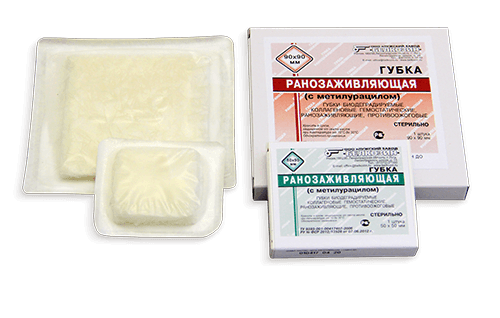
Biodegradable collagen wound-healing sponge – LLC LUGA PLANT “BELKOZIN”, manufactured according to modern technology.
A wound-healing sponge is a white plate of porous structure, with a specific smell of acetic acid, with a relief surface.
Wound-healing sponges are prepared from a collagen solution. The composition of the wound-healing sponge includes methyluracil. Clinical trials were conducted on the basis of Pavlov First Saint Petersburg State Medical University, Military Medical Academy named after S.M. Kirov, Department of Emergency Surgery of St. Petersburg in Medical Academy of Postgraduate Education.
THERAPEUTIC INDICATIONS:
- for the closure and treatment of extensive skin abrasions in children and adults received during fall,
- as a local remedy for the complex treatment of trophic ulcers,
- decubitus ulcers,
- deep and long-term non-healing wounds (postoperative cicatrix),
- with a diabetic foot,
- with violations of skin integrity and subcutaneous tissues in case of oncology.
The wound-healing sponge has an anti-inflammatory effect, stimulates the reparative processes in the wounds, accelerates the growth and maturation of the granulation tissue and epithelialization, and also has a haemostatic effect.
When applied on the wound, the wound-healing sponge tightly adheres to its surface, absorbs the wound discharge, swells and gradually lyses, releasing the methyluracil included in it.
METHOD OF APPLICATION:
The wound-healing sponge is applied to the wound surface in a form of an application so that it fits snugly against the bottom and walls of the wound, and the edges extend beyond the wound by 1-1.5 cm. Over the sponge a fixing bandage with a sticky bandage or gauze bandage is applied.
Previously the wound should be treated with solutions of antiseptics and the remains of necrotic tissue should be removed. In case of purulent discharge, it is recommended to use the product with antiseptic solutions (for example, dioxidine), wetting the product. The frequency of dressings depends on the depth and area of the wound surface, the intensity of exudation and the presence of necrotic masses. Drenched areas of the sponge are removed and replaced with new ones. On the average, the dressing is recommended to be done once in 2-3 days (if there are no wet areas), since during this period, the wound-healing sponge is completely lysed.
If the wound-healing sponge did not resolve and there are no indications for bandaging (pain, burning sensation in the wound area, accumulation of purulent exudate, the presence of allergic reactions), it is not removed until the complete healing by granulation tissue to the full depth.
The use of wound-healing sponges alleviates sufferings of a sick person and eliminates the expectation of painful daily dressings!
CONTRAINDICATIONS:
The use of a wound-healing sponge is contraindicated in the presence of a purulent discharge, purulent crusts, excessive granulation, and also in case of individual intolerance to methyluracil.
PACK SIZE:
The wound-healing sponge is available in a form of plates (50±5) × (50±5) mm and (90±10) × (90±10) mm, thickness (6±2) mm, in individual packaging. Sterile.
